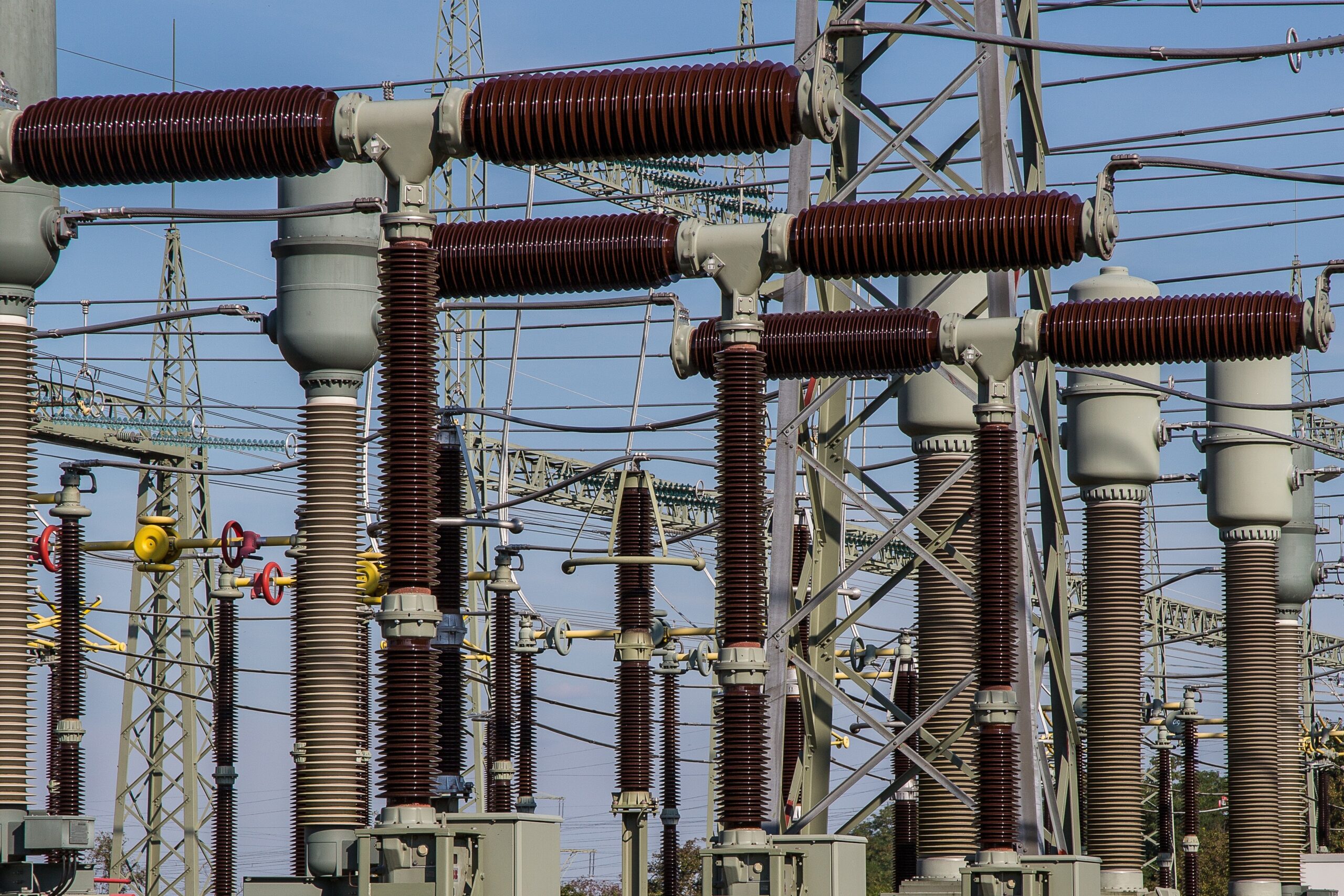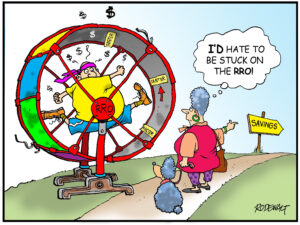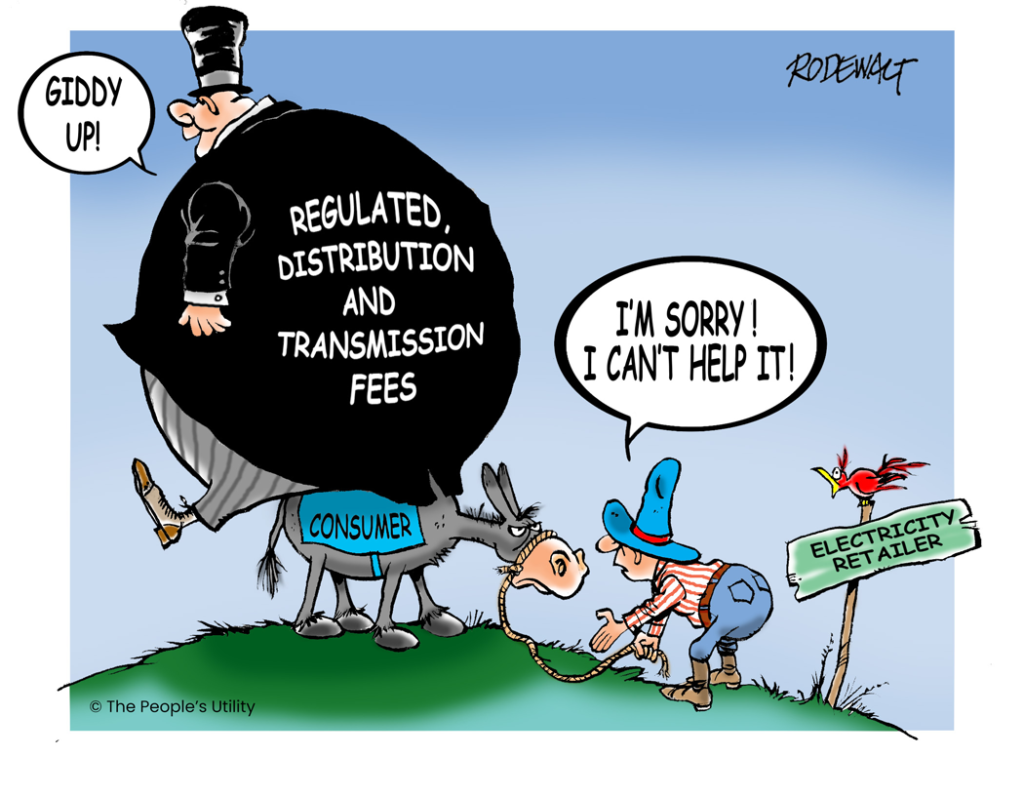
Throughout this mini blog series, we have shed light on the inner workings of the Alberta electricity market so that consumers hopefully better understand the charges on their electricity invoices.
RRO rates are up 70%: On August 1st, the Government Regulated Rate Option (RRO) for electricity increased to over 12 ¢/kWh. During the last three months, the rates charged by the regulated utilities (ENMAX, EPCOR, and Direct Energy) went up by over 70%.
Save Money: Camrose Energy can offer you lower guaranteed prices than today’s RRO rates.
Customer Choice: Tell the old utilities – enough is enough. Here is a list of two dozen retailers who will offer you lower rates than the massive price hike consumers on the RRO are going to be hit with this August. Shop local and save.
The goal of this blog, as always, is to help consumers more fully understand what is currently happening in Alberta’s energy market and help them make educated decisions when it comes to their electricity bills.
Welcome back to our mini blog series on the Alberta Electricity Market! To recap, the prices consumers pay for electricity is driven by the wholesale cost charged by generators in the province. The year-to-date wholesale price in 2021 is at a 20-year high. What went wrong?
- Part 1: We explored the fundamentals of the price-setting mechanism used by the Alberta Electric System Operator (AESO), called the ‘Merit Order,’ which describes how generators bid their supply of electricity into the market.
- Part 2: The setting of Power Pool prices is akin to a real-time auction. Generators offering the lowest price are dispatched first by AESO, and the last price bid to meet demand determines the price all generators are paid.
- Part 3: We examined how generation affects prices and the reasons for price spikes over recent months.
In response to questions raised by many consumers from our first three parts of this mini-series, the Department of Energy asked Alberta’s Utility Consumer Advocate (UCA) to update their website to try to help explain why the cost of energy in Alberta is increasing. They added a section to their website explaining how economic withholding works.
In this entry, we dig deeper into the differences between deregulated and regulated charges, with a focus on charges that fall under the categories of Distribution and Transmission. Some regulated charges have gone up five-fold! Find out why below.
Deregulation on Your Bill
You may have noticed that the charges on your electricity bill are divided into two main categories: usage/consumption and delivery charges. These names will vary from retailer to retailer, but ultimately they can be separated into deregulated and regulated charges. Let’s take a look at deregulated charges first and how they compare to regulated energy rates.
Under Alberta’s deregulated market, which came into effect in 2001, all consumers have a choice when it comes to their electricity retailer. You can choose to enroll with one of the incumbent retailers like ENMAX, EPCOR, or Direct Energy, or you can enroll with one of the smaller competitive retailers like Camrose Energy (one of 25 local energy marketers who service customers all across the province). By choosing a retailer, you have control over the cents per kilowatt-hour rate that you are charged for the energy you consume and any administration fees charged by the retailer. These are your deregulated charges.
Deregulated charges consist of consumption (aka usage or energy) charges that are dependent on how much you consume. When your meter is read, the amount of energy, measured in kilowatt-hours (kWh), is charged to you at a rate that you have chosen. These rates can be fixed or variable, depending on your preferences. Fixed rates are ones that hold steady for a given term or set period of time, and must be renewed at the end of their term. Variable rates fluctuate with the market and will vary depending on the Power Pool prices (for more on how Power Pool prices change, see Part 3 of this blog series). You can also choose the Regulated Rate Option (RRO) which is a government-regulated rate that changes from month to month. In June 2021, the price was 7 ¢/kWh. It increased to 10 ¢/kWh in July, and is currently at 12 ¢/kWh.
Also included in your deregulated charges are administration (admin) fees. Admin fees are basically a retailer’s way of making sure the costs of producing invoices, customer service, etc. are all covered. These fees will also vary from retailer to retailer, and some will charge a flat rate, while others charge on a per-day basis. For comparison, Direct Energy charges $12 per month for electricity, plus another $12 per month for natural gas. Camrose Energy’s rate is $6.25 for electricity and $5.25 for natural gas.
It is up to you as the consumer to shop around for the best electricity rate and administration fees available and choose a provider that’s right for you. The RRO option, although regulated by the government and the default retailer for all Albertans, is not always the best option in terms of price.
Distribution and Transmission (D&T)
Unfortunately, you only have control of roughly half the cost of your invoice. You can choose your rates, and you can control your consumption, but there are a host of other fees that we see most often as the subject of complaints about the high costs of energy that consumers have almost no control over. These are your regulated charges, which include distribution and transmission charges, balancing pool riders, as well as Local Access Fees (LAF) and municipal taxes. Your regulated charges are determined by the Alberta Utilities Commission (AUC) and apply regardless of which retailer you choose to service your home. Let’s break down what each of those means:
- Distribution Charges: These are costs that must be paid to the wires companies (also known as Wires Operators, Wires Service Providers, Distribution Facilities Owners, or Distribution Service Operators) for bringing the energy from the transmission system to your home. Depending on your service location, Distribution charges will flow through to a specific wires company (ATCO, ENMAX, EPCOR, Fortis Alberta, etc.). Distribution charges have fixed and variable components, which means a portion of these costs are based on your consumption, while the rest is based on a per-day calculation.
- Transmission Charges: These are costs that must be paid to transmission facility owners (ATCO, AltaLink, ENMAX, and EPCOR) for planning Alberta’s grid, and transporting energy from generation sources to distribution systems. The high-voltage power lines that traverse the province are costly to build and maintain, thus the high cost of Transmission charges. These charges flow through your retailer to the distribution companies, then to AESO, then to the transmission facility owners.
- Balancing Pool Allocation: This value, also known as Rider F, is also consumption-based and is set on a yearly basis as either a credit or a charge. The Balancing Pool is an independent government agency set up to backstop power purchase arrangements (PPAs) created when Alberta’s electricity industry was deregulated in the late 1990s. It’s required to forecast its revenues and expenses, which then determines an annualized cost or credit to all Alberta electricity customers.
- Local Access Fees/Municipal Franchise Fees: The Local Access Fees (LAF) and Municipal Franchise Fees (MFF) are charged by municipalities to distribution companies (i.e. wires owners) for the right to operate their infrastructure on municipal lands. LAF and MFF vary from municipality to municipality and are calculated on a per-kWh rate, as well as by a percentage of the total distribution charges. These fees are governed by the Municipal Government Act.
- Rate Riders: These temporary, additional rates are sometimes consumption-based and at other times have a percentage basis. Riders are given a letter designation (see Rider F above) and can be credits or charges. Rate riders are used to true-up finances by distribution companies and must be approved by the AUC.
It’s important to note that regulated charges are administered by the AUC, and go through a rigorous process to get approval before they can be applied to your bill. But how these charges (or credits) are calculated is not often displayed on your invoice, especially when the various components of a “Distribution Charge” get lumped together as a single line item.
Later this year, you will see an additional line item which will be another rider called “Utility Deferral Adjustment – EL” (or “Utility Deferral Adjustment – NG” for natural gas) that will persist until summer 2022. This rider will be used to cover the deferred amount that could not be collected by all retailers across the province over the course of the government’s Utility Payment Deferral Program from March 2020 to June 2021. This amount, estimated to be in the range of $20 million, will be socialized across all customers in the province as a rider (the impact on your monthly bill is estimated to be around 25 cents).
High Costs
A common complaint among consumers are the high costs of these extra charges, over and above the cost of electricity consumed. Today, in many cases, and depending on where you live, D&T fees represent from 45% to 70% of the overall cost on a consumer’s monthly invoice. The root concept of deregulation is often blamed for this. Let’s set the record straight: Generation and retailing of electricity are deregulated, but not delivery.
Since 2004, distribution charges have doubled, and over the same period, Alberta has seen a five-fold increase in transmission changes due to the expansion of infrastructure. The following charts illustrate the average monthly distribution and transmission charges, respectively, for residential RRO customers by service area over the last fourteen years.
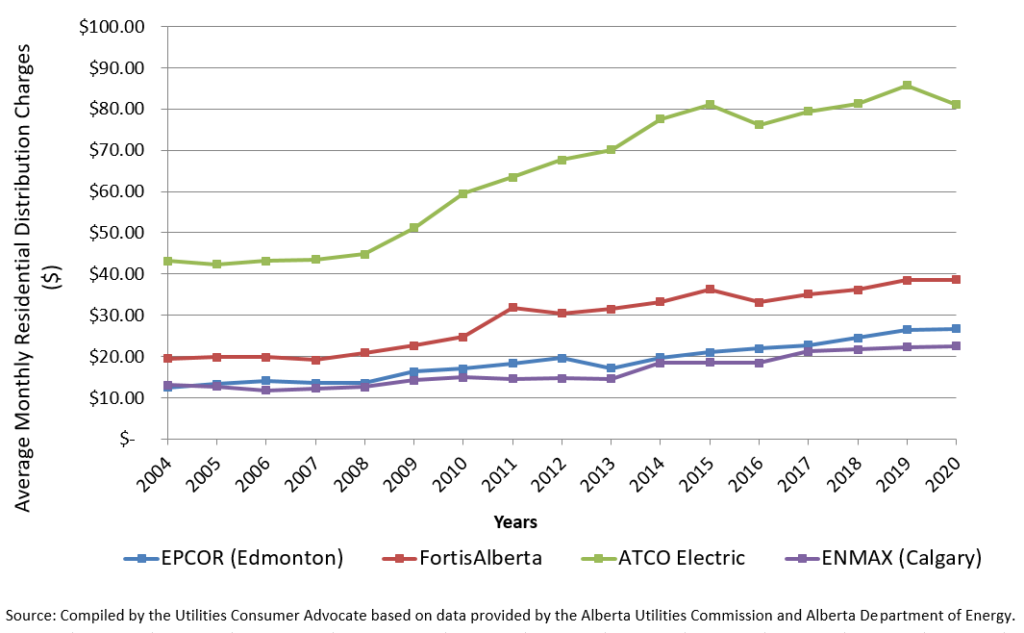
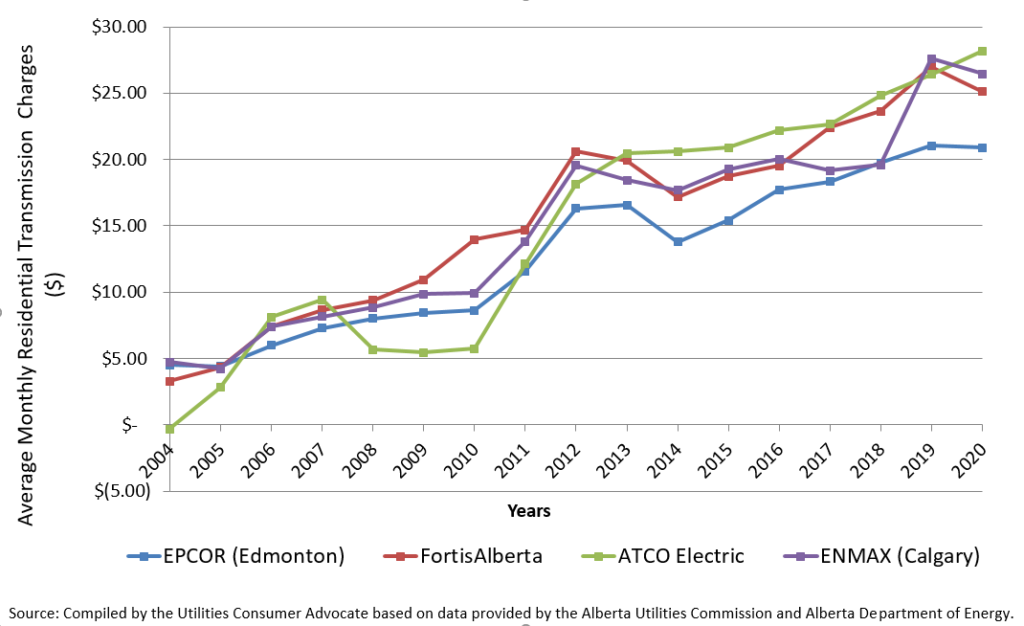
Distribution charges for Calgary (ENMAX), Edmonton (EPCOR), FortisAlberta, and ATCO Electric are regulated by the AUC (who is looking at ways of modernizing the system). Distribution charges for Cardston, Ponoka, Red Deer and Lethbridge are approved by local municipal governments and town councils. Rural Electrification Associations (REAs) have boards of directors responsible for approval of the distribution charges on behalf of members.
All transmission charges are approved and regulated by the AUC and are based on how much electricity the consumer has used.
The following analytics are based on four sample customer invoices, each using 600 kWh per month. If you lived in Edmonton, your invoice (including all charges: energy, admin, D&T, LAF) would have been just $100 during the month. If you were located elsewhere in the province and used the same amount of energy (at the same price per kWh), your invoice would range from 4% to 68% higher than in Edmonton.

Delivery costs vary with location and are significantly higher for customers in rural northern Alberta than in urban areas. If you live in ATCO territory, you pay more than those served by Fortis. The differential is primarily based on population density per kilometre of wires. In the example above, a customer in the ATCO territory pays over $118 for delivery (D&T) charges compared to approximately $48 for Calgary or Edmonton.
The other fee that is location-dependent is the Local Access Fee or LAF (this is sometimes also lumped together with a Municipal Franchise Fee, see definitions above). These fees are set by the municipality in which you live. In the example above, Calgary charges its homeowners significantly more than Edmonton’s city council does.
Managing Regulated Charges
You may have noticed that many of the regulated charges listed are consumption-based. That means that if you consume less energy each month, not only do your deregulated energy charges decrease, a portion of your regulated charges will also come down. In fact, almost all regulated charges have some consumption-based component, meaning YOU can affect those costs.
Unfortunately, as mentioned above, electricity retailers like Camrose Energy cannot control the regulated fees you see on your monthly utility bill. While we have and continue to, lobby the provincial government to review the ever-increasing regulated fees, we are but one small voice. Consumers who are frustrated with the regulated portion of their bill need to voice their concerns to the government. Contact your local MLA and let them know you think the regulated portion of your utility bill is too high.
Another way to offset the regulated charges on your bill is to consider installing a solar PV system at your home (Alberta Micro-Generation Regulation). By generating energy that can be exported back to the grid, you will earn credits that can be applied towards your bill and reduce the overall costs from month to month.
You can take a solar PV system one step further by joining our Solar Club. Membership is free; we only ask that members make a donation to a local food bank or charity of their choosing. Members of our Solar Club gain access to special rates that can be toggled depending on the season. Per the regulation, small micro-generators must be paid at the same rate for exports as they are charged for imports, so why not take advantage of this and get credited at our high rate of 25.85 cents/kWh in the summer months?
Advocating for Deregulation
Make no mistake, there’s no getting away from regulated charges on your energy bills. But that doesn’t change the success of deregulation in Alberta because there is healthy competition in the marketplace. So much so that retailers are competing with each other over tenths and hundredths of a cent when it comes to differences in rates. And because the differences between rates are so close, there are often other perks to enrolling with different retailers. As an example, Camrose Energy offers all new customers who sign up for electricity services 25 AIR MILES® Reward Miles on enrollment and a chance to win up to 1,000 Miles in monthly draws*.
*No purchase necessary. 1 winner is drawn monthly. Contest rules apply, click here to view contest rules. The contest ends on December 31, 2021.
Here’s the bottom line. If you are stuck on the old government RRO – it is time for a change. If you are buying your energy from companies that have shipped jobs out of the country, then consider the importance of buying local. You may save some money, but most importantly, you will be keeping the business in your local community.
We hope you found this mini blog series informative. Please reach out and support one of Alberta’s many independent retail energy providers.
Want to learn more about your own electricity bills? Switch over to Camrose Energy and get invoices that break down the distribution and transmission charges, showing you exactly how you’re being charged and why. This detailed invoice summary is just one of many reasons to switch to a competitive retailer like Camrose Energy. Not only are you supporting a local business, but you’ll also love our amazing Customer Care team who can answer all your questions! They’re local, just like you, and you’ll never be speaking to someone overseas!

